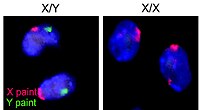
Back تكاثر الإنسان Arabic Reproduksyon nin tawo BCL মানব প্রজনন Bengali/Bangla Rozmnožování člověka Czech Menschliche Fortpflanzung German Reproducción humana Spanish زادآوری انسان Persian Ihmisen lisääntyminen Finnish Reproduction humaine French मानव प्रजनन Hindi
| Part of a series on |
| Sex |
|---|
 |
| Biological terms |
| Sexual reproduction |
| Sexuality |
| Sexual system |
Human sexual reproduction, to produce offspring, begins with fertilization. Successful reproduction typically involves sexual intercourse between a healthy, sexually mature and fertile male and female.[1] During sexual intercourse, sperm cells are ejaculated into the vagina through the penis, resulting in fertilization of an ovum to form a zygote.[1]
While normal cells contain 46 chromosomes (23 pairs), gamete cells contain only half that number, and it is when these two cells merge into one combined zygote cell that genetic recombination occurs.[citation needed] The zygote then undergoes a defined development process that is known as human embryogenesis, and this starts the typical 38-week gestation period[a] for the embryo (and eventually foetus) that is followed by childbirth.
Assisted reproductive technology also exists, like IVF, some of which involve alternative methods of fertilization, which do not involve sexual intercourse; the fertilization of the ovum may be achieved by artificial insemination methods.[2]
- ^ a b Jones, Richard E. (1991). "The Male Reproductive System". Human Reproductive Biology. Elsevier. pp. 72–93. doi:10.1016/b978-0-12-389770-1.50008-1. ISBN 978-0-12-389770-1.
- ^ Ombelet, W.; Van Robays, J. (2015). "Artificial insemination history: hurdles and milestones". Facts, Views & Vision in ObGyn. 7 (2): 137–143. PMC 4498171. PMID 26175891.
Cite error: There are <ref group=lower-alpha> tags or {{efn}} templates on this page, but the references will not show without a {{reflist|group=lower-alpha}} template or {{notelist}} template (see the help page).